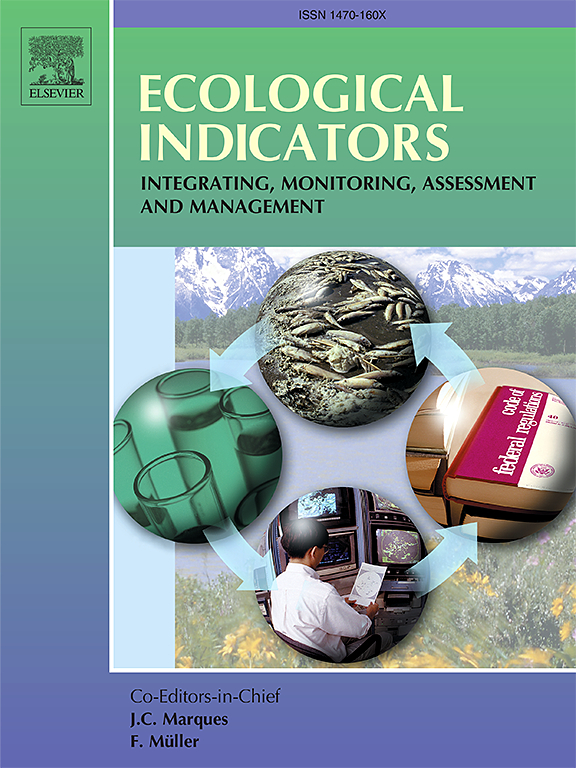Vegetation disturbance and recovery assessment through the synergistic effects of albedo and vegetation index: evidence from China’s arid regions
IF 7
2区 环境科学与生态学
Q1 ENVIRONMENTAL SCIENCES
引用次数: 0
Abstract
Vegetation disturbance and recovery are key factors in shaping ecological governance policies in arid regions, especially under the accelerating impacts of global climate change. However, most studies focus on broad trends, often neglecting fine-scale spatial and temporal variations. In this study, we developed indices for vegetation disturbance and recovery based on kNDVI (kernel-based Normalized Difference Vegetation Index) and surface albedo, combined with the LandTrendr algorithm, to assess vegetation dynamics in China’s arid regions from 2000 to 2023. Our results show that compared to traditional indices, the new indices capture subtle changes in vegetation disturbance and recovery with greater accuracy. Approximately 63.26 % of the region experienced at least one disturbance, primarily in the north-central arid regions, while 27.64 % experienced multiple disturbances, and 36.74 % remained undisturbed. Around 80.14 % exhibited recovery, mostly in the northern Tibetan Plateau, the vegetated margins of the Tarim Basin, and western Mongolian Plateau. The innovative combination of kNDVIand Albedo enhances the accuracy of vegetation dynamics assessment, offering a transferable Indicator for monitoring dryland ecosystems globally. These findings provide valuable insights into ecosystem resilience and inform ecosystem restoration strategies in the context of climate change.

基于反照率和植被指数协同效应的植被干扰与恢复评价——来自中国干旱区的证据
在全球气候变化加速影响下,植被干扰与恢复是影响干旱区生态治理政策的关键因素。然而,大多数研究都侧重于宏观趋势,往往忽视了精细尺度的时空变化。基于kNDVI (kernel-based Normalized Difference vegetation Index)和地表反照率,结合LandTrendr算法,建立了2000 - 2023年中国干旱区植被扰动与恢复指数。结果表明,与传统指数相比,新指数能更准确地捕捉植被扰动和恢复的细微变化。63.26%的地区至少经历过一次干扰,主要集中在中北部干旱区,27.64%的地区经历过多次干扰,36.74%的地区未受到干扰。恢复率约为80.14%,主要集中在青藏高原北部、塔里木盆地植被边缘和蒙古高原西部。kndvi和反照率的创新组合提高了植被动态评估的准确性,为全球旱地生态系统监测提供了可转移的指标。这些发现为研究气候变化背景下的生态系统恢复力和生态系统恢复策略提供了有价值的见解。
本文章由计算机程序翻译,如有差异,请以英文原文为准。
求助全文
约1分钟内获得全文
求助全文
来源期刊

Ecological Indicators
环境科学-环境科学
CiteScore
11.80
自引率
8.70%
发文量
1163
审稿时长
78 days
期刊介绍:
The ultimate aim of Ecological Indicators is to integrate the monitoring and assessment of ecological and environmental indicators with management practices. The journal provides a forum for the discussion of the applied scientific development and review of traditional indicator approaches as well as for theoretical, modelling and quantitative applications such as index development. Research into the following areas will be published.
• All aspects of ecological and environmental indicators and indices.
• New indicators, and new approaches and methods for indicator development, testing and use.
• Development and modelling of indices, e.g. application of indicator suites across multiple scales and resources.
• Analysis and research of resource, system- and scale-specific indicators.
• Methods for integration of social and other valuation metrics for the production of scientifically rigorous and politically-relevant assessments using indicator-based monitoring and assessment programs.
• How research indicators can be transformed into direct application for management purposes.
• Broader assessment objectives and methods, e.g. biodiversity, biological integrity, and sustainability, through the use of indicators.
• Resource-specific indicators such as landscape, agroecosystems, forests, wetlands, etc.
 求助内容:
求助内容: 应助结果提醒方式:
应助结果提醒方式:


